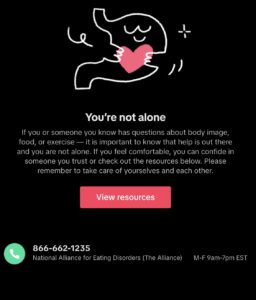#Skinnytok is a hashtag used on many social media platforms such as TikTok. It is used to promote unhealthy eating patterns and extreme thinness. But it is also the latest buzzword for extremism when it comes to unhealthy approaches to eating and exercise.
Several videos include “body checking,” which is when a person repeatedly and excessively examines their body and measures their weight.
@dailyedthoughts I feel so discussting, but I’ll be better tomorrow #modivation #wl #fyp #binge #wieiad ♬ Child Psychology – Black Box Recorder
@bones_and_nothing_else Healthy meals 🫶🏻 #dietcoke #love #fyp #lifestyle #hungry #zerosugar #ednotedsheerannn #healthy #yummy ♬ original sound – 𝘮𝘪𝘢 ༅࿐
@propessor_igat ITS HARD THO😝😝#PropFit #gymrat #MYWORKOUTOUTFIT💪🏽 ♬ Coco Jamboo – Mr. President
Table of Contents
#skinnytok’s Content Highlights Dangerous Habits
Other videos include unhealthy eating habits, such as consuming a very low number of calories, which can be observed in the “What I eat in a day” videos. They may also include excessive exercising, the use of non-prescribed weight loss pills, weight loss transformations, and low-calorie recipes.
Several terms have been adopted to promote excessive skinniness, including “nothing tastes better than being skinny,” “is it an outfit or are you just skinny,” and “be the smallest in the room.”
These videos are often masked as inspirational, featuring inspirational music in the background or captions. These inspirational captions can make it seem like these behaviors are healthy and positive when they are very dangerous. One can internalize these habits and continue engaging in disordered eating or obsessive patterns.
There is a concern that these videos can cause depression or anxiety, or even cause or exacerbate eating disorders such as anorexia nervosa or bulimia. Eating disorders are unfortunately not something that can be easily controlled and can have a long-lasting negative impact on one’s life.
These eating disorders have become much more prevalent in recent years, as one study shows a 15.3% increase in eating disorders during the pandemic.
While eating disorders such as anorexia nervosa and bulimia nervosa have been stereotyped as issues only affecting white people, this idea is highly flawed. According to the National Eating Disorders Association (NEDA), eating disorders “affect people from all demographics of all ethnicities at similar rates. People of color — especially African Americans — are significantly less likely to receive help for their eating issues.”
According to a study published in the International Journal of Eating Disorders, “Black teenagers are 50% more likely than white teenagers to display bulimic behavior such as bingeing or purging. Though this is true, treatment rates for black teenagers were substantially lower than for white teenagers.
According to a study performed, of 76 women who have had an eating disorder, 28.1% of the white women received treatment while 5.3% of the black women received treatment for the eating disorder. These disparities highlight just how vital it is to both address inequalities in healthcare and to stop harmful social media trends such as #Skinnytok. #Skinnytok can lead to disordered eating behaviors, especially amongst underrepresented groups who may not see themselves in the mainstream narratives of recovering from eating disorders.
What is TikTok Doing to Help?
As of June 2, 2035, TikTok has removed the hashtag #SkinnyTok to protect children online. If the hashtag is searched, TikTok will provide a link to resources that can be visited for help, such as the phone number for the National Alliance for Eating Disorders: 866-622-1635.

Here’s What To Do When You See a Video.
Though TikTok has removed the hashtag #skinnytok, there are still ways that people can post these videos and avoid having them taken down. For example, people have used the captions to bypass the hashtag removal, including misspelling skinnytok as “skinnyt0k” or “sk1nnytok” or referencing eating disorders in some way.
- If you come across this video, there is a feature on TikTok where you can click “not interested.” When you do, TikTok can remove videos like these from your FYP, for your page feed.
- You can also report the video or block the creator of the video.
Resources
Black, Indigenous, and People of Color (BIPOC) and Eating Disorders, National Eating Association.org























